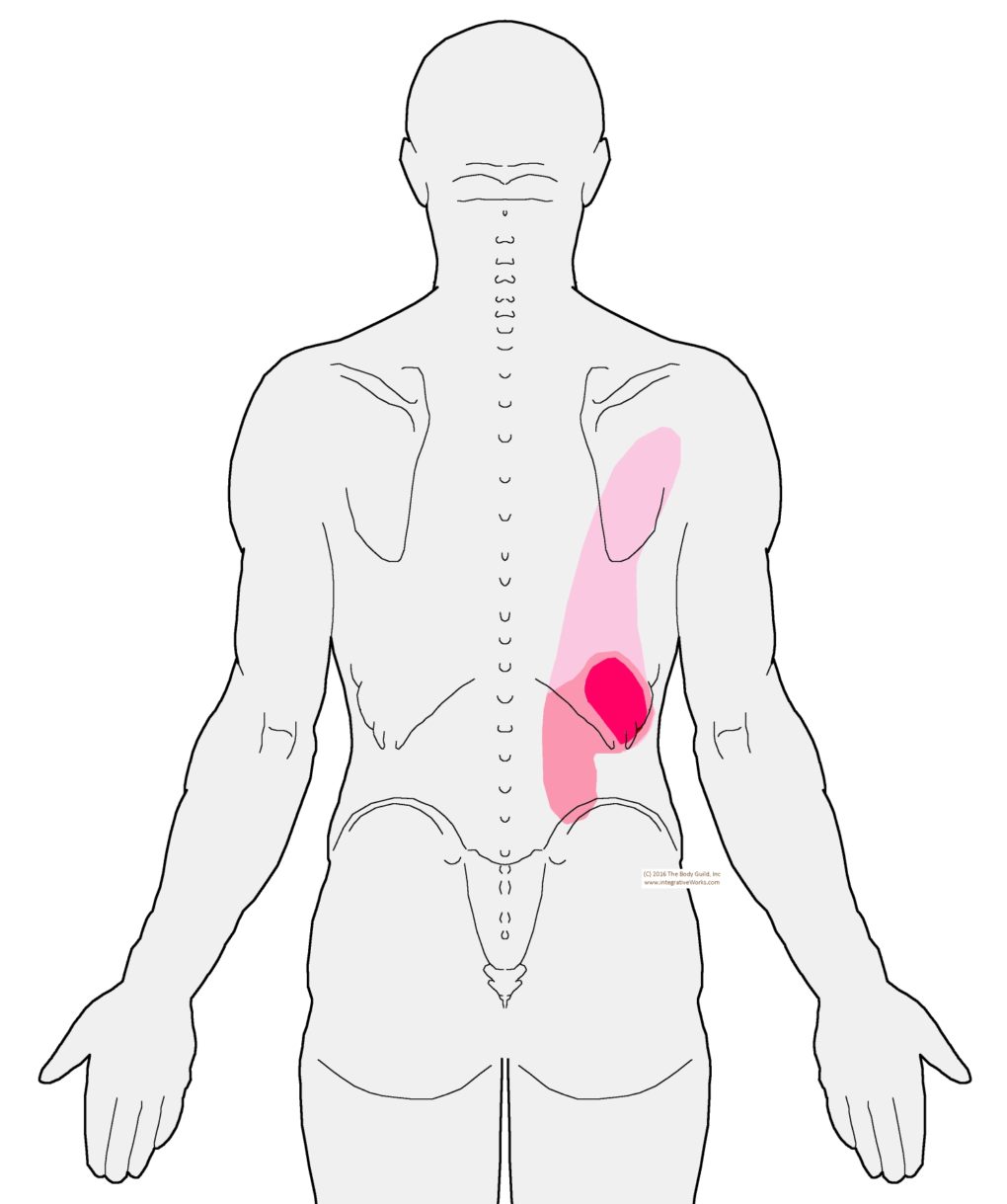Mid back Pain with Stiff Low Back
Table of Contents
- How People Describe This Pain Pattern
- How You Activate and Intensify This Pain Pattern
- Self-Care – Getting Relief on Your Own
- Musculoskeletal Anatomy Behind Your Pain
- Therapy Notes for Massage and Bodywork
How People Describe This Pain Pattern


People complain of pain in the mid-back. They almost always make this awkward move where they reach back to touch the lower ribs on that side. Often, they complain about a stiff low back. They may even refer to it as low back pain as they touch the lower ribs. At times, they complain of how it extends up to the outside of the shoulder blade.
It bothers them when they are cycling or pulling weeds. Unlike other low back problems, this seems to be connected to breathing deeply while bending forward. This pain tends to ache. In contrast, most low back pain feels sharp and fragile.
Because of its involvement in breathing, this often hurts when people sneeze or cough.
Could this be serious?
It could be either. Here, we discuss one of the muscular trigger points that cause it. However, it could be the gallbladder or kidneys. It is best to see your doctor.
For many, this trigger point refers forward to the abdomen. In my experience, people talk about how it wraps around to the front. However, most trigger point research cites it as referring forward and a little downward through the abdomen.
This pain pattern is particularly bothersome on the right, where appendix pain flares up. Most of my clients have already contacted their physician to check for gastrointestinal issues. If they have not, I refer them out to have it checked and avoid working in the abdomen until we confirm it is safe.
How You Activate and Intensify This Pain Pattern
Deep Breathing While Bent Forward
The muscle that creates this mid back pain with a stiff low back, iliocostalis thoracis, helps depress the ribs in deep breathing. It gets to be a more likely problem in clients over 45. In the mid-40s, the sacroiliac joint starts to fuse, and the low back muscles typically atrophy. Typically, cycling is more appealing at this age as it is less painful and injury-prone than running.
Awkward Reaching and Twisting
This pain pattern also bugs people when they are reaching and twisting. This muscle helps to extend and twist the back. Combined with deep breathing, it can create an achy pain in the mid back. Awkward and imbalanced reaching and twisting can be the activity that jams a joint and starts it all. In this case, the stiff low back is more noticeable.
The Musculoskeletal Anatomy Behind Your Pain
Musculoskeletal Anatomy
This post on anatomy contains standard information about the origin, insertion, function, and innervation of muscles. Additionally, it includes information on functional considerations and anomalies.
Find Related Posts
Anatomy posts have a grid of all related posts. This includes posts on pain patterns, self-care, therapy notes, NMT protocols, cranial techniques, and cases.
Getting Relief on Your Own
Clinically Proven
Self-Care Strategies
This post has strategies for getting relief on your own. Explore how to change your activities, stretch, ice, and more to relieve the pain associated with this trigger point.
Therapy Notes for Massage and Bodywork
Better Bodywork
Through Shared Expertise
This post has techniques, tips, treatment routines, and anatomy illustrations to improve the bodyworker’s approach.
Support Integrative Works to
stay independent
and produce great content.
You can subscribe to our community on Patreon. You will get links to free content and access to exclusive content not seen on this site. In addition, we will be posting anatomy illustrations, treatment notes, and sections from our manuals not found on this site. Thank you so much for being so supportive.
Cranio Cradle Cup
This mug has classic, colorful illustrations of the craniosacral system and vault hold #3. It makes a great gift and conversation piece.
Tony Preston has a practice in Atlanta, Georgia, where he sees clients. He has written materials and instructed classes since the mid-90s. This includes anatomy, trigger points, cranial, and neuromuscular.
Question? Comment? Typo?
integrativeworks@gmail.com
Follow us on Instagram
*This site is undergoing significant changes. We are reformatting and expanding the posts to make them easier to read. The result will also be more accessible and include more patterns with better self-care. Meanwhile, there may be formatting, content presentation, and readability inconsistencies. Until we get older posts updated, please excuse our mess.